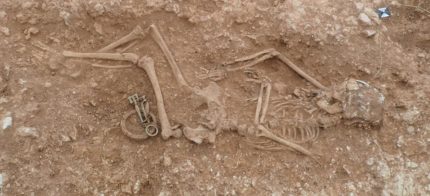 University of Sheffield archaeologists have discovered an Anglo-Saxon cemetery in Scremby, Lincolnshire. The burials of more than 20 individuals were unearthed at the site in the Lincolnshire Wolds. They date from the late 5th century to the mid-sixth and virtually all of them include rich grave goods.
University of Sheffield archaeologists have discovered an Anglo-Saxon cemetery in Scremby, Lincolnshire. The burials of more than 20 individuals were unearthed at the site in the Lincolnshire Wolds. They date from the late 5th century to the mid-sixth and virtually all of them include rich grave goods.
It was those grave goods that alerted archaeologists to the presence of the cemetery. A local metal detector hobbyist exploring the field discovered a number of Anglo-Saxon pieces of jewelry and weapon fittings and responsibly notified the Lincolnshire Finds Liaison Officer. Because the objects found — gilded brooches, spear heads, iron shield bosses — are indicators of Anglo-Saxon era burials, archaeologists were brought in to excavate the site.
Dr Hugh Willmott, Senior Lecturer in European Historical Archaeology from the University of Sheffield, said: “Almost without exception, the burials were accompanied by a rich array of objects, in keeping with the funerary rites adopted during the early centuries of the Germanic migrations to eastern England.
“What is particularly interesting is the significant proportion of very lavish burials which belonged to women. These women wore necklaces made from sometimes hundreds of amber, glass and rock crystal beads, used personal items such as tweezers, carried fabric bags held open by elephant ivory rings, and wore exquisitely decorated brooches to fasten their clothing.
“Two women even received silver finger rings and a style of silver buckle commonly associated with Jutish communities in Kent. Furnished burials belonging to males were also identified, including a number buried with weaponry such as spears and shields.”

Individual child burials have not been found so far in the cemetery. The only child unearthed was an infant buried with an adult woman. The baby was cradled in the woman’s left arm.
The skeletal remains discovered in the burial ground are in good condition and will be extensively analyzed to learn more about the early Anglo-Saxon community that inhabited the area. The bones will be given a full osteological examination at the University of Sheffield Department of Archaeology. Stable isotope analysis of the teeth will reveal where the deceased grew up based on the kind of food they ate and water they drank as children.
The metal artifacts will also be tested for the elemental composition of alloys and the ivory rings to identify the species of elephant they came from.